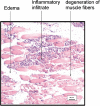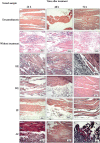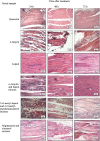Anti-inflammatory effects in muscle injury by transdermal application of gel with Lychnophora pinaster aerial parts using phonophoresis in rats
- PMID: 24138803
- PMCID: PMC3874755
- DOI: 10.1186/1472-6882-13-270
Anti-inflammatory effects in muscle injury by transdermal application of gel with Lychnophora pinaster aerial parts using phonophoresis in rats
Abstract
Background: Lycnophora pinaster is used by the traditional Brazilian medicine for the treatment of inflammations. Anti-inflammatory activity of Lycnophora pinaster was investigated for extracts, fractions, and isolated compounds of their aerial parts. The hexane extract (HE) provided α-amyrin, lupeol, mixture of α-amyrin and lupeol, mixture of 3-O-acetyl-lupeol and 3-O-acetyl-pseudotaraxasterol, and mixture of the steroids stigmasterol and sitosterol. The aqueous extract (WE) provided a fraction containing alkaloids (AF) and another one containing phenolic compounds (PF).
Methods: The crude hexane extract obtained from aerial parts of L. pinaster was submitted to chromatographic fractionation. The fractionation of PF was performed by preparative HPLC analysis, providing the flavonoid quercetin. The extracts, fractions, and compounds isolated from L. pinaster were tested to evaluate the anti-inflammatory activity by experimental model of impact injury, followed by transdermal application of gels with these samples. The application of the gels was performed using phonophoresis in rat paws after induction of muscle injury. Histological analysis was based on scores assigned by the capacity of decreasing the lesion.
Results: HE and WE exhibited anti-inflammatory activity. Some fractions, triterpenes, and steroids also reduced the inflammatory infiltrates caused by muscle injury. Lupeol promoted a significant reduction of inflammation. Quercetin also provided significant results, promoting the greatest decreases in muscle injury.
Conclusion: The results of this work suggest that topical application of triterpenes, steroids and flavonoid significantly decreases the inflammatory process generated by muscle injury. The transdermal application using phonophoresis in rat paws of gel with lupeol and quercetin attenuates the inflammation.
Figures




References
-
- Alcântara AFC, Silveira D, Chiari E, Oliveira AB, Guimarães JE, Raslan DS. Comparative analysis of the trypanocidal activity and chemical properties of E-lychnophoric acid and its derivatives using theoretical calculations. Eclet Quim. 2005;30:37–45. doi: 10.1590/S0100-46702005000300005. - DOI
-
- Merten J, Hennig A, Schwab P, Fröhlich R, Tokalov SV, Gutzeit HO, Metz P. A concise sultone route to highly oxygenated 1,10-seco-eudesmanolides-enantioselective total synthesis of the antileukemic sesquiterpene lactones (-)-Eriolanin and (-)-Eriolangin. Eur J Org Chem. 2006;5:1144–1161.
-
- Taleb-Contini SH, Santos WF, Mortari MR, Lopes NP, Lopes JL. Neuropharmacological effects in mice of Lychnophora species (Vernonieae, Asteraceae) and anticonvulsant activity of 4,5-di-O-[E]-caffeoylquinic acid isolated from the stem of L. rupestris and L. staavioides. Basic Clin Pharmacol Toxicol. 2008;102:281–286. doi: 10.1111/j.1742-7843.2007.00194.x. - DOI - PubMed
Publication types
MeSH terms
Substances
LinkOut - more resources
Full Text Sources
Other Literature Sources

